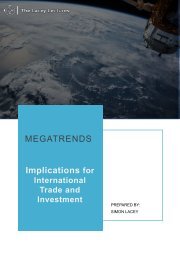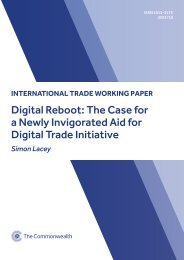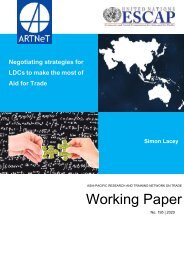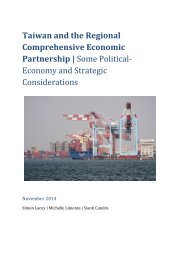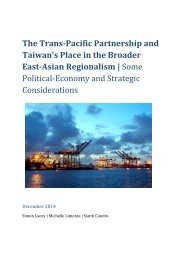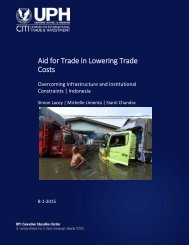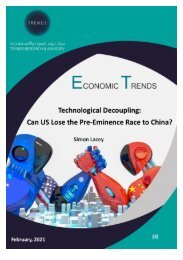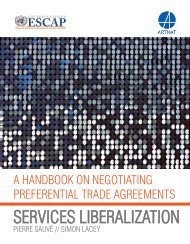Cross Border Data Flows: The impact of data localisation on IoT
This industry report seeks to shed new light on the costs of imposing data localization requirements or other restrictions on cross-border data flows with respect to the important economic growth likely to result from the uptake and adoption of IoT in manufacturing, agriculture and other important sectors of the economy. It chooses 3 large emerging markets in order to showcase its model, namely Brazil, Indonesia and South Africa.
This industry report seeks to shed new light on the costs of imposing data localization requirements or other restrictions on cross-border data flows with respect to the important economic growth likely to result from the uptake and adoption of IoT in manufacturing, agriculture and other important sectors of the economy. It chooses 3 large emerging markets in order to showcase its model, namely Brazil, Indonesia and South Africa.
Create successful ePaper yourself
Turn your PDF publications into a flip-book with our unique Google optimized e-Paper software.
CROSS-BORDER DATA FLOWS: THE IMPACT OF DATA LOCALISATION ON IOT<br />
Scenario 1: <strong>IoT</strong> generates new gains compared to today.<br />
<str<strong>on</strong>g>The</str<strong>on</strong>g>re are two types <str<strong>on</strong>g>of</str<strong>on</strong>g> efficiency gains from <strong>IoT</strong><br />
deployment in our model: the productivity gains within<br />
the ec<strong>on</strong>omy; and the trade-enhancing effects when<br />
the ec<strong>on</strong>omy trades with other ec<strong>on</strong>omies.<br />
In the first instance, we shock the model by using the<br />
productivity gains from GSMA Intelligence (2019)<br />
to Brazil, Ind<strong>on</strong>esia, South Africa and the rest <str<strong>on</strong>g>of</str<strong>on</strong>g> the<br />
world that agglomerates all other ec<strong>on</strong>omies in the<br />
model. <str<strong>on</strong>g>The</str<strong>on</strong>g> productivity shocks are introduced as TFP<br />
increases that apply to the domestic ec<strong>on</strong>omy.<br />
In other words, we assume that the global ec<strong>on</strong>omy<br />
deploys <strong>IoT</strong> applicati<strong>on</strong>s according to the GSMA<br />
Intelligence (2019) calculati<strong>on</strong>s for the year 2025.<br />
Obviously, this baseline assumes ceteris paribus for<br />
all other technologies, policy measures or ec<strong>on</strong>omic<br />
developments aside from the extrapolati<strong>on</strong> described<br />
in the previous chapter. <str<strong>on</strong>g>The</str<strong>on</strong>g> TFP shocks from the GSMA<br />
Intelligence study are:<br />
Table 1<br />
Domestic productivity increase due to <strong>IoT</strong>.<br />
Percentage change in the respective country/regi<strong>on</strong> from <strong>IoT</strong> technology.<br />
Total Factor Productivity (TFP) change (%)<br />
Brazil 0.27<br />
Ind<strong>on</strong>esia 0.24<br />
South Africa 0.17<br />
Rest <str<strong>on</strong>g>of</str<strong>on</strong>g> the world 0.34<br />
In additi<strong>on</strong> to the domestic shocks, we also introduce<br />
a productivity effect ‘at the border’ for imports <str<strong>on</strong>g>of</str<strong>on</strong>g><br />
trade and services from overseas. This trade efficiency<br />
<str<strong>on</strong>g>impact</str<strong>on</strong>g> <str<strong>on</strong>g>of</str<strong>on</strong>g> <strong>IoT</strong> applies c<strong>on</strong>currently with the domestic<br />
productivity increase identified by GSMA Intelligence<br />
(2019).<br />
<str<strong>on</strong>g>The</str<strong>on</strong>g> trade efficiency-enhancing effect from <strong>IoT</strong> is<br />
based <strong>on</strong> the <str<strong>on</strong>g>impact</str<strong>on</strong>g> <str<strong>on</strong>g>of</str<strong>on</strong>g> c<strong>on</strong>nectivity <strong>on</strong> trade which<br />
was identified in the WTO study cited above. How <strong>IoT</strong><br />
reduces the import prices <str<strong>on</strong>g>of</str<strong>on</strong>g> goods and services and<br />
increase product variety is estimated for a similar point<br />
in time, i.e. after approximately seven years .25<br />
Table 2<br />
Import efficiency due to <strong>IoT</strong>.<br />
Percentage change in the respective country/regi<strong>on</strong> from <strong>IoT</strong> technology.<br />
Trade cost change: AMS (%)<br />
Brazil -0.68<br />
Ind<strong>on</strong>esia -1.88<br />
South Africa -4.82<br />
Rest <str<strong>on</strong>g>of</str<strong>on</strong>g> the world -0.62<br />
25. This trade efficiency shock is denoted Aggregate Measurement <str<strong>on</strong>g>of</str<strong>on</strong>g> Support (AMS) shock in the GTAP model<br />
13




